Mariya I. Vasileva
HandsOff: Labeled Dataset Generation With No Additional Human Annotations
Dec 24, 2022Abstract:Recent work leverages the expressive power of generative adversarial networks (GANs) to generate labeled synthetic datasets. These dataset generation methods often require new annotations of synthetic images, which forces practitioners to seek out annotators, curate a set of synthetic images, and ensure the quality of generated labels. We introduce the HandsOff framework, a technique capable of producing an unlimited number of synthetic images and corresponding labels after being trained on less than 50 pre-existing labeled images. Our framework avoids the practical drawbacks of prior work by unifying the field of GAN inversion with dataset generation. We generate datasets with rich pixel-wise labels in multiple challenging domains such as faces, cars, full-body human poses, and urban driving scenes. Our method achieves state-of-the-art performance in semantic segmentation, keypoint detection, and depth estimation compared to prior dataset generation approaches and transfer learning baselines. We additionally showcase its ability to address broad challenges in model development which stem from fixed, hand-annotated datasets, such as the long-tail problem in semantic segmentation.
OutfitTransformer: Learning Outfit Representations for Fashion Recommendation
Apr 15, 2022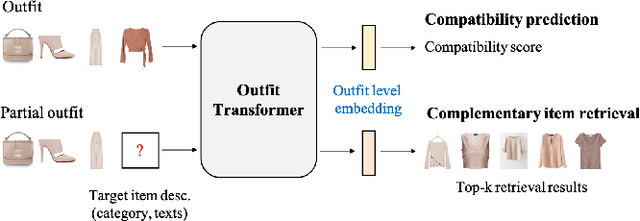
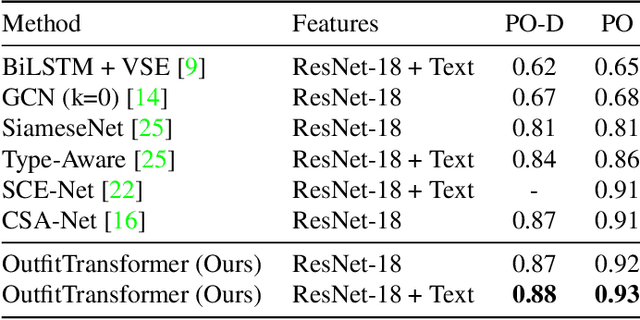
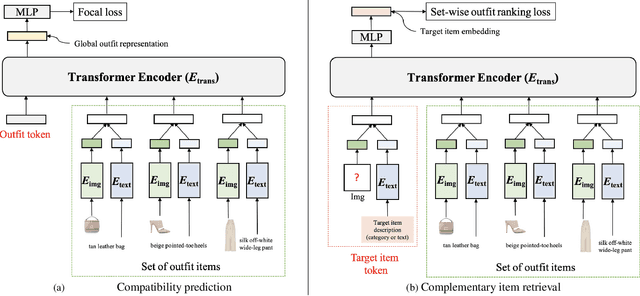

Abstract:Learning an effective outfit-level representation is critical for predicting the compatibility of items in an outfit, and retrieving complementary items for a partial outfit. We present a framework, OutfitTransformer, that uses the proposed task-specific tokens and leverages the self-attention mechanism to learn effective outfit-level representations encoding the compatibility relationships between all items in the entire outfit for addressing both compatibility prediction and complementary item retrieval tasks. For compatibility prediction, we design an outfit token to capture a global outfit representation and train the framework using a classification loss. For complementary item retrieval, we design a target item token that additionally takes the target item specification (in the form of a category or text description) into consideration. We train our framework using a proposed set-wise outfit ranking loss to generate a target item embedding given an outfit, and a target item specification as inputs. The generated target item embedding is then used to retrieve compatible items that match the rest of the outfit. Additionally, we adopt a pre-training approach and a curriculum learning strategy to improve retrieval performance. Since our framework learns at an outfit-level, it allows us to learn a single embedding capturing higher-order relations among multiple items in the outfit more effectively than pairwise methods. Experiments demonstrate that our approach outperforms state-of-the-art methods on compatibility prediction, fill-in-the-blank, and complementary item retrieval tasks. We further validate the quality of our retrieval results with a user study.
Learning Similarity Conditions Without Explicit Supervision
Aug 22, 2019



Abstract:Many real-world tasks require models to compare images along multiple similarity conditions (e.g. similarity in color, category or shape). Existing methods often reason about these complex similarity relationships by learning condition-aware embeddings. While such embeddings aid models in learning different notions of similarity, they also limit their capability to generalize to unseen categories since they require explicit labels at test time. To address this deficiency, we propose an approach that jointly learns representations for the different similarity conditions and their contributions as a latent variable without explicit supervision. Comprehensive experiments across three datasets, Polyvore-Outfits, Maryland-Polyvore and UT-Zappos50k, demonstrate the effectiveness of our approach: our model outperforms the state-of-the-art methods, even those that are strongly supervised with pre-defined similarity conditions, on fill-in-the-blank, outfit compatibility prediction and triplet prediction tasks. Finally, we show that our model learns different visually-relevant semantic sub-spaces that allow it to generalize well to unseen categories.
Why do These Match? Explaining the Behavior of Image Similarity Models
May 26, 2019



Abstract:Explaining a deep learning model can help users understand its behavior and allow researchers to discern its shortcomings. Recent work has primarily focused on explaining models for tasks like image classification or visual question answering. In this paper, we introduce an explanation approach for image similarity models, where a model's output is a semantic feature representation rather than a classification. In this task, an explanation depends on both of the input images, so standard methods do not apply. We propose an explanation method that pairs a saliency map identifying important image regions with an attribute that best explains the match. We find that our explanations are more human-interpretable than saliency maps alone, and can also improve performance on the classic task of attribute recognition. The ability of our approach to generalize is demonstrated on two datasets from very different domains, Polyvore Outfits and Animals with Attributes 2.
Learning Type-Aware Embeddings for Fashion Compatibility
Jul 27, 2018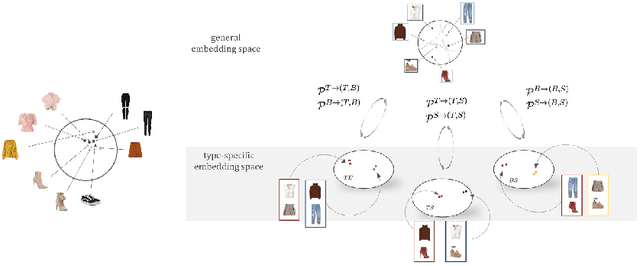

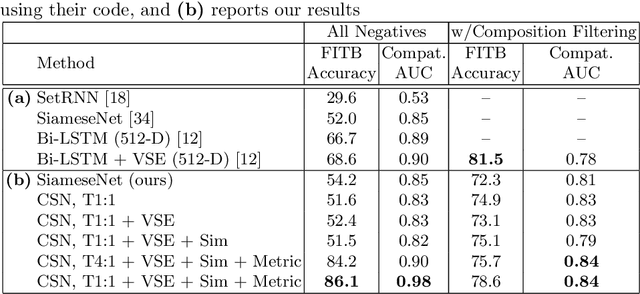
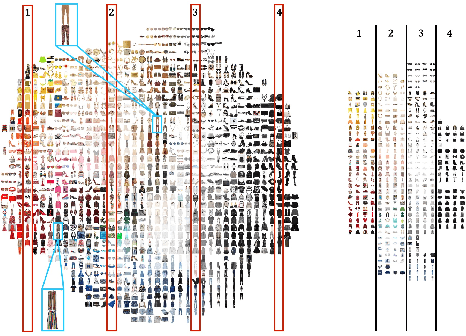
Abstract:Outfits in online fashion data are composed of items of many different types (e.g. top, bottom, shoes) that share some stylistic relationship with one another. A representation for building outfits requires a method that can learn both notions of similarity (for example, when two tops are interchangeable) and compatibility (items of possibly different type that can go together in an outfit). This paper presents an approach to learning an image embedding that respects item type, and jointly learns notions of item similarity and compatibility in an end-to-end model. To evaluate the learned representation, we crawled 68,306 outfits created by users on the Polyvore website. Our approach obtains 3-5% improvement over the state-of-the-art on outfit compatibility prediction and fill-in-the-blank tasks using our dataset, as well as an established smaller dataset, while supporting a variety of useful queries.
 Add to Chrome
Add to Chrome Add to Firefox
Add to Firefox Add to Edge
Add to Edge